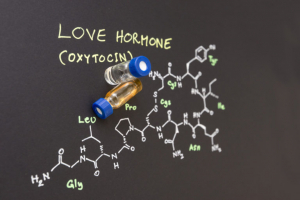Oxytocin, also known as the “love hormone,” plays a key role during pregnancy and childbirth, but not only. This hormone is produced long before a couple decides to have a baby, at all stages of sexual activity. In particular, its production increases with stimulation of the nipples, genitals, and skin in general. Even in men, sexuality is associated with oxytocin levels, which promote erection and sperm motility.
How does oxytocin affect emotions?
Oxytocin reduces anxiety and stress, thereby promoting overall well-being and interpersonal relationships, both sentimental and friendly. High levels of this hormone have an effect similar to that of a small dose of alcohol. However, like alcohol, excessive levels of oxytocin lead to the opposite effect and, therefore, to consequences such as anger and irritability. Oxytocin preparations are used in the treatment of depression.
Specialists of the Bogolyuby Medical Center draw attention to the fact that the role of oxytocin in the perinatal period has not yet been studied in depth, including because cultural models of behavior that differ in different societies are added to simple scientific data. The effects of oxytocin during pregnancy are associated with the construction of relationships between mother and child.
How to stimulate oxytocin production?
This is facilitated by a calm environment, hugs, stimulation of the nipples, genitals and skin. Low levels of oxytocin can be observed in situations that cause discomfort. This is even more important to consider during pregnancy, when the level of this hormone in the final phase should be higher to facilitate labor and delivery itself.
In addition to the many environmental stimuli that promote the synthesis and release of oxytocin, the level of this hormone in both men and women can also be influenced by nutrition. Products that stimulate the production of oxytocin include, for example, pomegranate, vanilla, chocolate, strawberries, honey and bananas. These same products are known for their aphrodisiac properties, which confirms the connection between oxytocin and sexuality.
What is the role of oxytocin during labor?
The hypothalamus is where impulses concerning basic human behavior, including procreation and survival, originate. Oxytocin plays a crucial role here: its job is to initiate labor. In fact, it stimulates the smooth cells of the uterus to move from the resting phase to the active phase. Its level increases at various stages of labor due to the pressure of the fetus on the receptors of the cervix and the vaginal wall, which, like the pituitary gland, produce a certain amount of oxytocin. In the final phase, oxytocin levels increase three or four times, which facilitates the expulsion of the fetus.
But what happens if oxytocin is too low during labor? In these cases, its synthetic version can be used to stimulate labor itself, as well as in cases where the pregnancy period has expired and this can lead to damage to the fetus. Using oxytocin to induce labor is an ideal solution when the pregnant woman’s cervix is already dilated.
What is the role of oxytocin in lactation?
Another fundamental function of oxytocin is during breastfeeding. In fact, after the baby is born, oxytocin levels do not decrease to trigger milk production. Oxytocin and breastfeeding are closely related . It has already been emphasized above that the production of this hormone increases with nipple stimulation.
The nervous irritation that occurs as a result of sucking on the nipples further increases the level of oxytocin. In addition to this “mechanical” function, the role of oxytocin in the relationship between mother and child should not be underestimated: one of its main properties is precisely the strengthening of the maternal instinct.



















